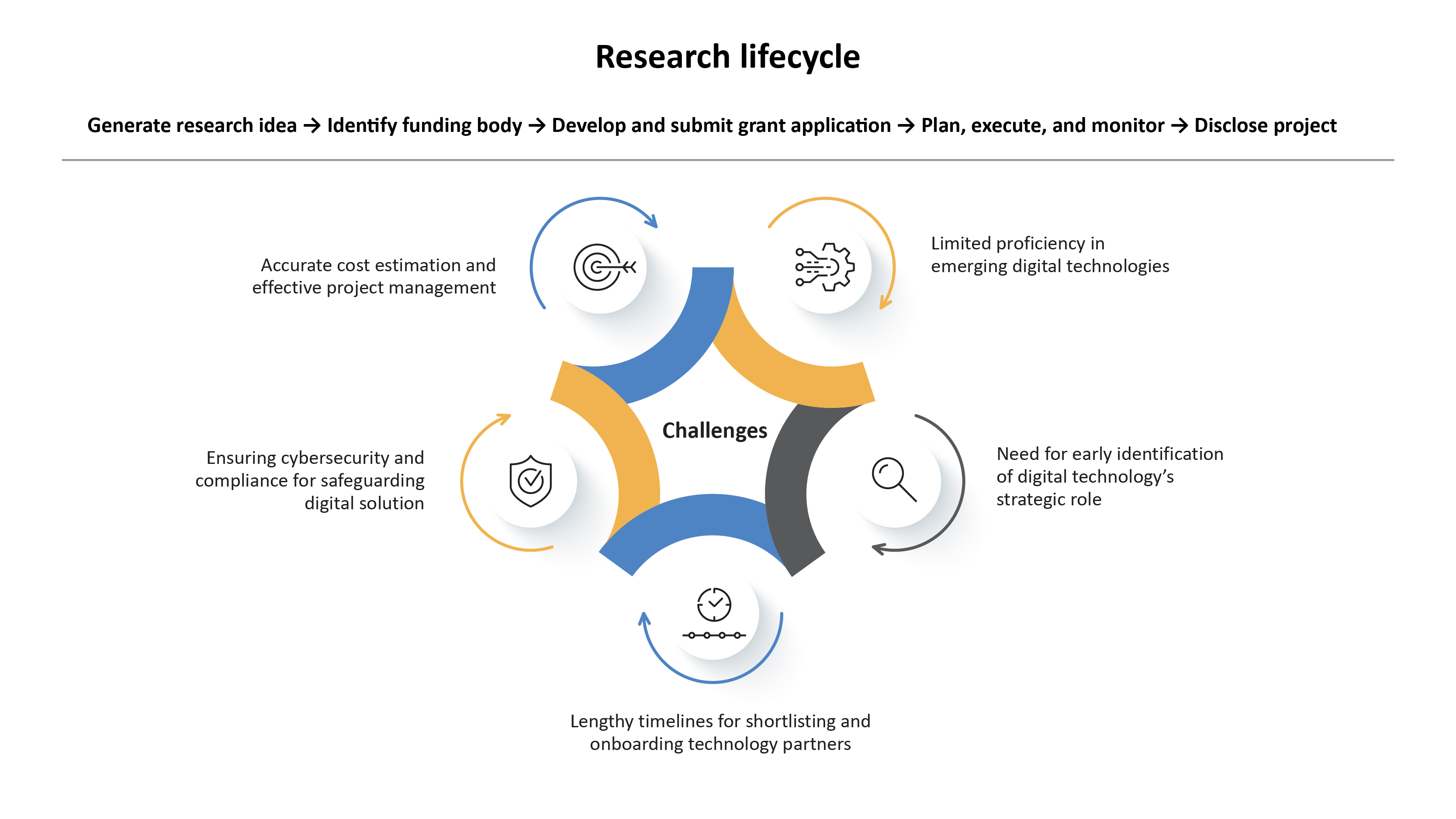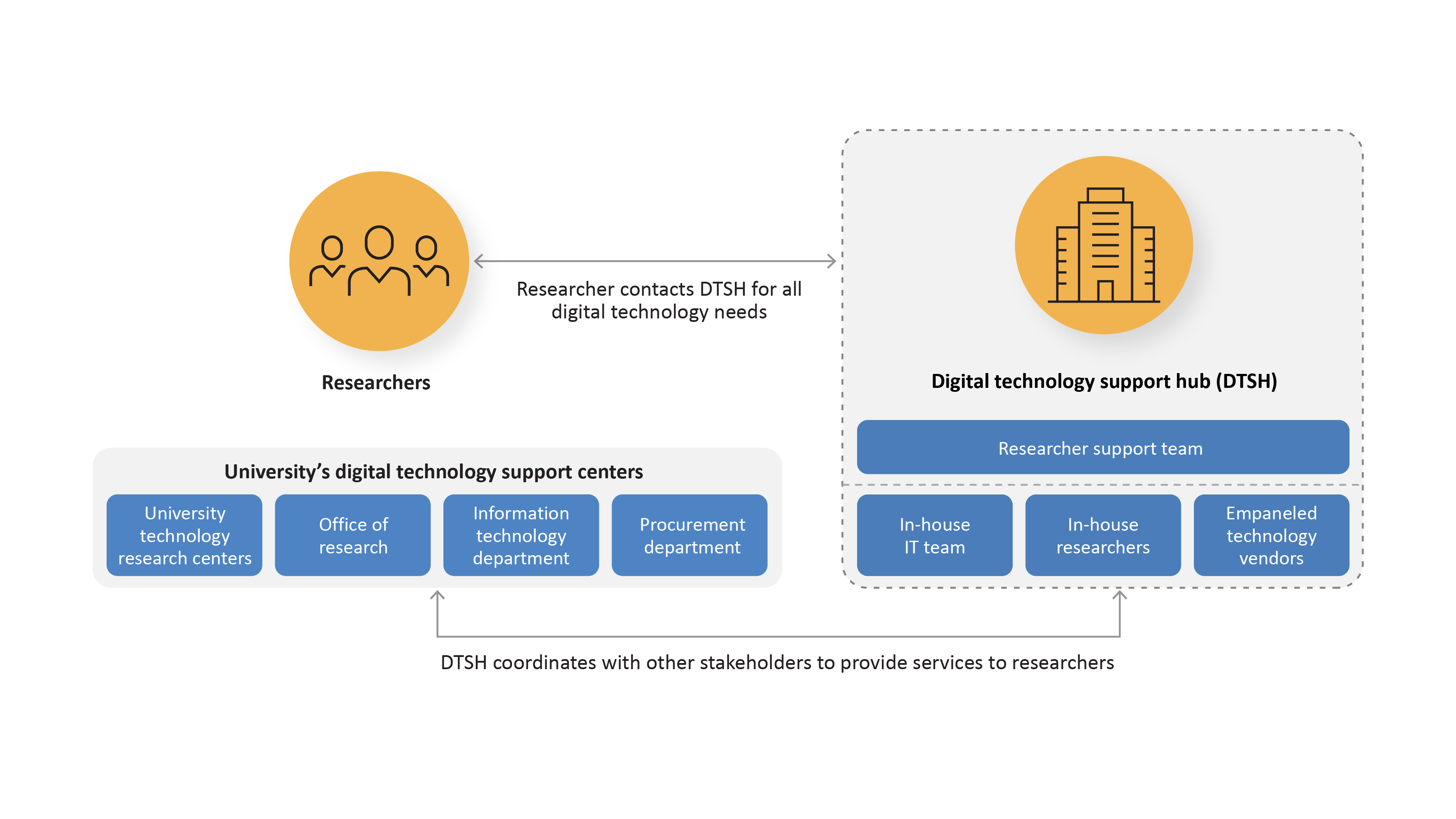INDUSTRY
Highlights
- Universities recognize the need for digital technology support to improve their research output and quality.
- Digital technologies can help researchers make their research scalable and easy to commercialize. These can also make the entire research process a lot more efficient, accurate, and transparent.
- A centralized digital technology support hub model can streamline digital services for researchers to foster innovation, improve productivity, and drive key business outcomes.
On this page
Research: A source of innovation and income for universities
Research has long been a cornerstone of higher education, serving as a source of innovation and revenue.
However, with the growing complexity of research methodologies and the proliferation of digital tools, universities are grappling with the need to offer adequate digital support to their researchers. The digital revolution has introduced various technologies—from advanced data analytics and machine learning to cloud-based collaboration platforms—that researchers can leverage to enhance their work.
In today's academic landscape, digital tools and technologies have become fundamental to conducting impactful research, driving the need for tailored support frameworks that address the diverse needs of researchers.
Universities are acknowledging the growing demand for robust digital technology support to elevate research outcomes and quality. Hence, they are implementing various digital support frameworks, though the maturity and sophistication of these services vary across institutions.
Rather than adopting a one-size-fits-all approach, universities are building digital support models based on their unique needs and resources. Leading institutions have established centralized digital hubs that offer comprehensive services, including technology consultations, access to cutting-edge research tools, and support for data management.
These dedicated hubs provide consultancy and concierge support to researchers for their digital technology needs. They enable researchers to access both internal resources and vetted third-party vendors for tailored digital solutions. This model can improve research efficiency and foster innovation by ensuring seamless collaboration between researchers and technology providers.
The growing importance of digital technology in research
Digital technologies can make research scalable and easy to commercialize while enhancing accuracy, transparency, and effectiveness.
By leveraging advanced digital solutions, institutions can support researchers in managing vast volumes of data, providing intelligent insights, and streamlining administrative processes, allowing researchers to focus more on their core academic work. For example, the University of Cambridge has implemented Cambridge Digital Services, which offers researchers robust infrastructure for data management and analytics, improving both the scalability of research and its commercialization potential.
A digital support model has proven successful in turning academic projects into market-ready innovations. Key elements and challenges of such a model include:
- Advanced digital infrastructure: A state-of-the-art infrastructure can support large-scale data processing, artificial intelligence (AI), and machine learning (ML) tools. Institutions can provide high-performance computing clusters that allow researchers to process massive datasets and generate advanced models, enabling groundbreaking discoveries in fields like genomics and climate science.
- IT application development services: While many universities offer in-house IT application development, the capacity and expertise often remain limited. This highlights the need for standardized development practices across institutions.
- Consultancy and project management support: Many universities, including the University of Oxford, have established dedicated research centers to provide digital consultancy and project management. However, these services are often siloed, requiring researchers to navigate multiple departments for different support aspects. This decentralized model can lead to inefficiencies, as teams may lack a cohesive view of the project’s goals and requirements.
- Collaboration with IT experts: High levels of collaboration between researchers and IT experts are essential for successful digital transformation. IT specialists work directly with research teams to develop tailored digital solutions that enhance research outcomes. This collaborative approach ensures that researchers can harness the full potential of digital tools without compromising on quality or security.
- Training and development in digital research skills: Recognizing the importance of digital proficiency, universities such as Imperial College London have launched comprehensive training programs and workshops aimed at equipping researchers with the necessary digital skills. These initiatives range from data analysis and visualization to cloud computing, ensuring that researchers are well-versed in the technologies that will shape the future of academic research.
Key phases of the research life cycle and associated high-level technology related challenges are depicted below:
The need for centralized, standardized digital support
To maximize the benefits of digital transformation in research, universities must move toward centralized, standardized support systems.
By adopting an integrated digital hub model, institutions can streamline access to digital tools, infrastructure, and consultancy services, ensuring that researchers receive consistent, high-quality support.
Furthermore, aligning digital project management with uniform technology standards will enhance security, performance, and scalability, reducing the risks associated with decentralized services. A centralized system can also provide a big-picture view of each research project, helping to coordinate efforts across departments and improving the overall quality of the research outputs.
As the research landscape becomes increasingly digital, universities face mounting pressure to provide dedicated digital support services for their researchers. Below are the critical factors underscoring the need for such support:
Awareness and access to digital capabilities and services: Researchers often vary in their understanding of digital technologies and their potential applications within research projects. Additionally, access to existing digital services can be limited or fragmented. In some cases, universities may offer robust digital support, but researchers may be unaware of these services or lack a clear mechanism to connect with the relevant teams. This lack of awareness can lead to missed opportunities to utilize available resources, ultimately hindering the research process.
For example, the University of Melbourne has addressed this issue by establishing a centralized Research Technology Services platform, a digital resource hub for researchers. This platform offers clear guidelines, contacts, and services related to IT tools and data management, ensuring researchers can easily navigate and leverage the university's digital infrastructure.
Digital capability and capacity gaps: In the rapidly evolving technology landscape, universities often struggle to maintain in-house expertise across all relevant areas. Even when institutions have specific capabilities—such as through dedicated research centers or IT departments—these resources may be limited and stretched thin by competing priorities. For example, a university’s AI research team may be fully engaged in its projects, leaving little bandwidth to support other departments with AI needs. These capacity constraints can delay research initiatives and prevent the full potential of digital tools from being realized.
At Stanford University, introducing the Digital Research Infrastructure program was a strategic move to close these capability gaps. This initiative connects researchers with digital specialists across various fields, from AI to data security, while ensuring that project timelines are maintained through streamlined access to in-house and external experts.
Cumbersome and complex processes: The process of specifying digital solutions, managing procurement, onboarding vendors, and handling contract management can be overly complex and time-consuming for researchers. Lengthy administrative procedures, lack of standardization, and bureaucratic hurdles often result in significant project delays, causing frustration among researchers and diminishing the quality of the digital components in their work.
A proactive, structured approach
The need for dedicated digital technology support in universities is driven by several factors.
These include researchers' varying awareness of digital tools, gaps in institutional capacity, and cumbersome administrative processes. By centralizing access to digital services, closing capability gaps, and simplifying operational procedures, universities can better equip their researchers to harness the full potential of digital technologies.
The establishment of a digital technology support hub can streamline access to digital services, simplify administrative processes, and drive research outcomes by offering comprehensive and specialized support in a single location.
Key features of a digital technology support hub are:
Single point of contact (SPOC): The hub serves as a centralized, single point of contact for all researcher digital needs, covering everything from initial consultancy and project management support to IT infrastructure, application development, and digital service access. For example, at the University of Cambridge, the Cambridge Digital Innovation Hub provides an integrated digital services platform that allows researchers to quickly access the necessary tools and support, leading to more efficient project initiation and completion.
Inhouse technical capability: The hub can house its technical capabilities in areas not already covered by existing university research centers or IT departments. This allows the hub to fill technology gaps with in-house expertise or through partnerships with verified vendors. For instance, Harvard University’s Institute for Quantitative Social Science has developed its data science team to assist with research that requires advanced analytics, ensuring that the necessary skills are readily available. This capability could be gathered through in-house technical resources or empaneled vendors.
Engage with other university entities: The hub can act as an intermediary, coordinating with other university entities such as research centers, IT departments, and procurement offices on behalf of researchers. This reduces the burden on researchers to navigate complex university structures and provides them with seamless technological support without being bogged down by administrative hurdles.
While universities may tailor the functions of the hub based on their specific needs, key services could include:
- Digital infrastructure and application development services: Providing access to IT infrastructure, cloud services, and custom application development.
- Integrated project management and consultancy: Offering end-to-end project management, from digital strategy consulting to execution
- Capacity building and training: Conducting courses and workshops on digital research techniques to enhance researchers' technical proficiency
- In-house research and innovation: Conducting independent research in emerging technology areas to foster innovation and self-reliance within the hub
Driving business outcomes with a digital technology support hub
A well-structured digital technology support hub can deliver significant business value by driving key performance indicators aligned with research and operational excellence. Potential outcomes include:
- Reduction in cybersecurity risks
The hub can help mitigate potential data breaches or vulnerabilities by ensuring that all digital solutions comply with university-wide cybersecurity policies. - Streamlined vendor management
A centralized hub can reduce the number of technology vendors needed across various research portfolios, lowering administrative overhead. - Optimized technology costs
With a centralized procurement strategy, universities can negotiate better pricing and service agreements, optimizing technology spending. - Improved digital asset management
The hub can ensure long-term data preservation and compliance with data privacy and retention policies by integrating with digital asset libraries and data management platforms. - Enhanced researcher experience
The hub can improve the overall research experience by providing streamlined access to digital services and reducing administrative delays. Researchers can focus more on their core work than on navigating complex digital systems.
A strategic investment
A digital technology support hub can benefit researchers, research centers, and universities.
It is a strategic investment for universities aiming to enhance research efficiency, reduce operational costs, and improve compliance with cybersecurity and data privacy standards. The hub serves as a concierge service for all researcher technology needs, reducing the administrative burden on researchers. It provides researchers with prompt access to expert digital support and guidance, helping them overcome technical challenges swiftly. The hub can be crucial in capacity building by offering courses on digital research methodologies and tools. This strengthens the knowledge base of both new and experienced researchers, facilitating the sharing and reusability of digital competencies across projects.
By offering comprehensive support—from project initiation to digital infrastructure access—the hub allows researchers to focus on their core activities.
Institutions that adopt such centralized support models can streamline digital services to foster innovation, improve researcher satisfaction, and drive key business outcomes. Universities should consider this model a critical enabler of future-ready research in the digital era.








